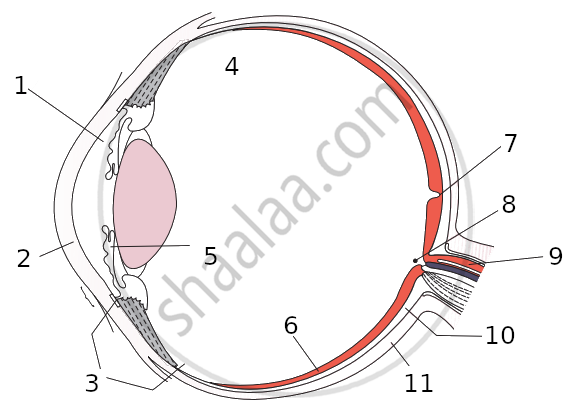Advertisements
Advertisements
प्रश्न
The image of an object at an infinite distance is obtained in a real and erect form through a convex magnifying glass.
विकल्प
Right
Wrong
उत्तर
The image of an object at an infinite distance is obtained in a real and erect form through a convex magnifying glass- Wrong
APPEARS IN
संबंधित प्रश्न
List the parts of the human eye that control the amount of light entering into it. Explain how they perform this function.
Write the function of the following part of the human eye: crystalline lens
Write the function of the following part of the human eye: ciliary muscles
How does the eye regulate the amount of light that falls on the retina?
Describe the anatomy of the human eye.
The optical prescription for a pair of spectacles is :
Right eye : −3.50 D
Left eye : −4.00 D
Which is the weaker eye?
What is the name of:
the light-sensitive layer in the eye?
What is the:
near point of a normal human eye?
Explain the functions of the following parts of the eye:
(i) cornea
(ii) iris
(iii) pupil
(iv) ciliary muscles
(v) eye-lens
To focus the image of a nearby object on the retina of an eye:
(a) the distance between eye-lens and retina is increased
(b) the distance between eye-lens and retina is decreased
(c) the thickness of eye-lens is decreased
(d) the thickness of eye-lens is increased
What shape are your eye-lenses:
when you look at your hand?
A man driving a car can read a distant road sign clearly but finds difficulty in reading the odometer on the dashboard of the car. Which of the following statement is correct about this man?
(a) The near point of his eyes has receded away.
(b) The near point of his eyes has come closer to him.
(c) The far point of his eyes has receded away.
(d) The far point of his eyes has come closer to him.
Out of animals of prey and predators, which have their eyes:
on the opposite sides of their head?
Five persons A, B, C, D and E have diabetes, leukaemia, asthma, meningitis and hepatitis, respectively.
Which of these persons cannot donate eyes?
Differentiate between members of the following pair with reference to what is asked in bracket.
Rod and cone cells (pigment contained)
Mention if the following statement is true (T) or false (F) Give reason.
yellow spot of the retina is the region of colour vision
Given below is a set of five parts. Rewrite them in correct sequence.
Conjunctiva, retina, cornea, optic nerve, lens.
With reference to the functioning of the eye, answer the question that follow:
What is the shape of the lens during distant vision?
Define the following:
Yellow spot
Define the following:
Blind spot
What is meant by power of accommodation of the eye?
Differentiate between:
Yellow spot and Blind spot.
Name the following:
The region in the eye where the rods and cones are located.
What is the nature of the image that forms on the retina?
Give Technical Term:
The cells of the retina that are sensitive to colour.
Choose the Odd One Out:
Choose the Odd One Out:
Complete the following sentence with appropriate Word
The part of the human eye where rod cells and cone cells are located is the:
Complete the following sentence with appropriate Word
The photoreceptor cells of the retina sensitive to colour are:
Write an Explanation.
Minimum distance of distinct vision
Write the function of the human eye and label parts of the figure given below.

The larynx has fold of tissue which vibrate with the passage of air to produce sound.
Select the option with incorrect identification:

Match the following:
| Column - I | Column - II |
| 1. Retina | a) Path way of light |
| 2. Pupil | b) Far point comes closer |
| 3. Ciliary muscles | c) near point moves away |
| 4. Myopia | d) Screen of the eye |
| 5. Hypermetropia | e) Power of accommodation |
Arrange and rewrite the term in group in correct order to be in a logical sequence, beginning with the term that is underlined:
Pupil, Aqueous humour, Retina, Vitreous humour.
Assertion (A): Rods and Cones are photoreceptors in the sclera of eyeball.
Reason (R): Rods are sensitive to dim light.
Name the following:
Two pigments of the sensory cells.
Name the following:
Three layers of the eye ball.
Differentiate between members of the following pair with reference to what is asked in the bracket.
Aqueous humour and vitreous humour (location).
